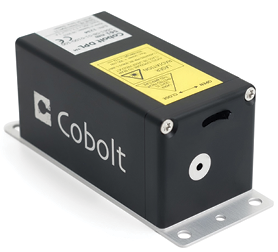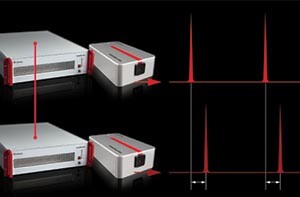Focus on photonics, spectroscopy, and spectrometry
DOI: 10.1063/pt.hxdc.odpu
Compact modulated laser for bioimaging
Hübner Photonics has added a 594-nm-wavelength laser to the Cobolt 06‑01 modulated laser series. The 06-DPL 594 nm has 100 mW output power. It can be directly modulated in either digital or analog mode up to 50 kHz, making it suitable for exciting red fluorophores, such as AF594, mCherry, and mKate2, that are often used in optogenetics and other bioimaging applications. Active power control during modulation ensures an ideal linear optical response and stable illumination from the first pulse and for any duty cycles and power levels. All Cobolt lasers are manufactured using proprietary HTCure technology; the resulting compact, hermetically sealed package provides a high level of reliability and immunity to varying environmental conditions. Cobolt lasers can be used in both laboratory and industrial environments. Hübner Photonics Inc, 2635 N First St, Ste 202, San Jose, CA 95134, https://hubner-photonics.com

Dual-color laser system
Toptica has released its FemtoFiber ultra dual-color laser system for multicolor nonlinear microscopy applications. The femtosecond fiber laser features two synchronized laser lines, making it suitable for simultaneous multicolor imaging and fluorescence lifetime imaging. It offers the advantages of a shared oscillator design for all-optical synchronization, a fixed delay between the two colors with minimum jitter, and a single electronic trigger output as a reference for time-correlated single photon counting and gated detection. Laser wavelength tuning is not needed. The FemtoFiber ultra dual-color laser system facilitates enhanced imaging of biological samples; in particular, metabolic imaging can especially benefit from the laser’s ability to perform simultaneous NADH (nicotinamide adenine dinucleotide hydrogen) and FAD (flavin adenine dinucleotide) measurements. Toptica Photonics Inc, 1120 Pittsford Victor Rd, Pittsford, NY 14534, www.toptica.com

Ebook on UV, visible, and near-IR microspectroscopy
AZoM, which reports news about materials science, has published the ebook UV-Vis-NIR Microspectroscopy for Materials Research: Key Applications and Case Studies. The information was sourced, reviewed, and adapted from materials provided by Craic Technologies, based in San Dimas, California. The ebook presents a comprehensive overview of cutting-edge microspectroscopy technologies and their applications and highlights how UV, visible, and near-IR microspectroscopy enables innovations in fields such as materials science, forensic analysis, nanotechnology, and life sciences. It offers insights into materials such as actinides, lanthanides, perovskites, liquid crystals, organic LEDs, and quantum dots. Case studies cover thin films and single crystals and their optical properties; effects of dopants and local defects on material performance; and guidance on integrating microspectroscopy in material development, from initial optimization to quality assurance. The ebook also introduces Craic Technologies’ instrumentation and software solutions. It is available on the Craic Technologies page on AZoM’s website. AZoNetwork UK Ltd, Neo, 4th Fl, 9 Charlotte St, Manchester M1 4ET, UK, www.azom.com

Optical beam-combining system
Sutter Instrument’s Lambda 721 system combines up to seven separate LED cubes with different spectra into a single common output beam. The cubes contain the LED, the collimating optics, and a filter. They are easily exchanged and installed without tools and without the need for a dichroic ladder, which restricts how the light sources are changed and in what order they are introduced into the optical path. With the Lambda 721, any LED cube can be placed in any of seven positions and in any order. Semrock STR filters are used for wavelength selection and beam reflection. Each cube is collimated before entering the optical path through the band-pass filter. The filters also function as mirrors that reflect the collimated beams from the previous light sources. Applications for the optical beam-combining system include fluorescence microscopy, calcium imaging, optogenetics, and high-speed wavelength selection. Sutter Instrument, 1 Digital Dr, Novato, CA 94949, www.sutter.com

